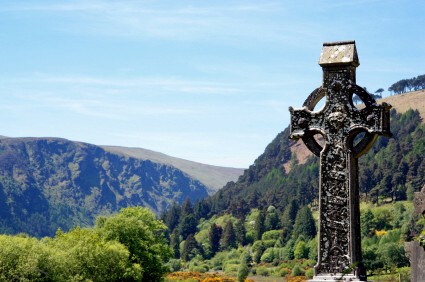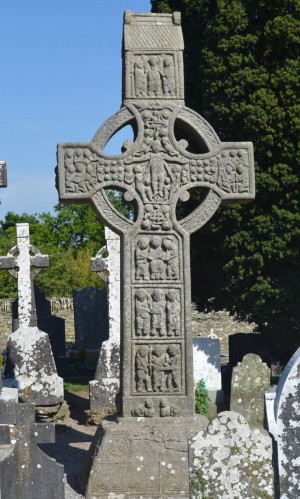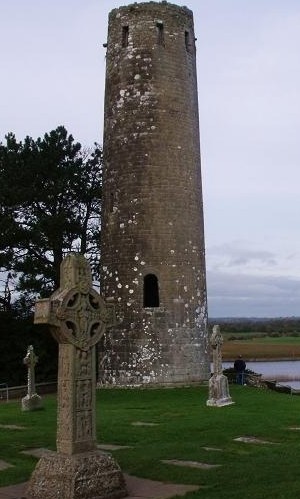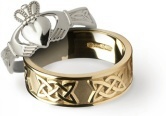Celtic Crosses
Celtic Crosses are exquisitely decorated symbols that are found throughout Ireland. These crosses are normally found on church grounds all across the country. The Celtic Cross can feature numerous unique patterns that include knots, interlaced ribbons, and spirals. The history of this well-known symbol is somewhat unclear. There are several interpretations about the original meaning and conception of the symbol. However, it is clear that this symbol represents the heritage and faith of the people of Ireland. Over the years, the Celtic Cross has also been associated with the people of Scotland, Wales, and Britain. For that reason, this symbol also gathered various cultural anecdotes.
 |
| Glendalough, County Wicklow |
For many, the Celtic Cross is synonymous with Ireland. This symbol is universally recognized as a religious symbol and a piece of Irish heritage. The original designs of the cross were carved in stone; however, modern versions are currently used for Celtic jewelry. This symbol has become popular for pendants and necklaces for both men and women. The design for these crosses can range from fairly plain to intricate and complex. In some cases, the cross is set with emeralds. This is a precious stone associated with Ireland. These beautifully designed crosses can be seen all across the country of Ireland as well as around the neck of a proud Ireland native.
History of the Celtic Cross
The original version of the cross dates back to around the 5th century A.D. These crosses were designed with a distinct circle placed at the intersection of the cross. They were typically decorated with geometric lines, curves, and spirals. Some versions are referred to as High Crosses. The early crosses were carved on top of slabs that laid flat on the ground. Over time, the symbol slowly progressed into carvings that were placed on slabs that stood upright. In some instances, these crosses were created with a rounded top. However, during the tenth century the crosses developed a more pitched roof at the top. The smallest cross created was around five feet tall and the largest was more than sixteen feet. The design of the cross incorporated a decorative circle of stone at the intersection that helped to strengthen the structure. Both variations of the cross were decorated intricately. Both variations also used Celtic patterns, spirals, and knot work.
As stated previously, the modern version of the Celtic Cross is a freestanding symbol. This cross is statuesque and the arms of the cross are significantly longer than previous crosses. The arms extend past the circle and the shapes are carved away. These crosses are commonly seen as gravestones and war memorials in Ireland and Britain respectively. Celtic Crosses can vary considerably in style and design. There are some crosses that are highly decorative while others are simple and plain. However, as a result of being carved in stone, their splendor has stood the test of time. Hundreds of years after being built, people can still appreciate them today.
Theories on the Celtic Cross
Depending on who is asked, the history of the cross has varying explanations. These interpretations can range from a casual description to an in-depth proclamation by a historical researcher. There is folklore, general banter, and modern research that all have unique interpretations on the history of this iconic religious symbol.
There is general banter throughout Ireland that suggests that the Celtic Crosses were carved from the standing stones of the Druids. The growing interest in pagan philosophies and the occult would propose that the circle at the intersection of the cross is the Sun that the Druids worshiped. There are Catholic priests in Ireland that suggest the circle of the Celtic Cross represents eternity and God’s endless love. Many people throughout Ireland believe that St. Patrick created the Celtic Cross. This theory suggests that St. Patrick combined the traditional cross with the pagan sun god, or the circle, to create the Celtic Cross. St. Patrick is said to have designed the first Celtic Cross by drawing a circle over a Latin cross.
There are various other theories that propose that the shape of the Celtic Cross was a symbol of Odin, the Norse God. Some Irish Catholics believe the circle on the cross is the halo of Christ. Other suggests that the distinctive shape is derived from the symbol Chi Rho. This theory was made popular by Constantine, a Roman emperor. There may be some validity to this claim because ‘Chi’ and ‘Rho’ are Greek for the first two letters of Christ. More importantly, when these two letters are interlinked, it resembles the center of a Celtic Cross.
Religious Significance
The most universal theory concerning the history of the Celtic Cross relates to its religious associations. In some instances, religious scripture is incorporated on different versions of the cross. When the Celts converted to Christianity, the Celtic Cross became a symbol of the Celtic Christian Church. For that reason, many Irish Catholics decided that the cross would represent their religion. This became a symbol of Christ that was commonly used in Christianity during the 4th century Roman Empire. The Emperor Constantine made Christianity the formal religion of the Roman Empire and used this symbol to represent this religion. As previously stated, they believed that the circle on the cross was a symbol of God's endless love and of eternity.
Some of the art on the Celtic Cross consists of nature and the supernatural. Depictions can include images of mythical figures, plants, animals, and humans.
The Interpretation of the Celtic Cross
The meaning behind the Celtic Cross incorporates the use of symbolism. In various traditions and cultures, the four arms on the cross are perceived as the four elements. These elements include water, earth, fire, and air. The four arms are also interpreted as the directions on a compass. The directions include north, south, east, and west. The four arms also include the four parts of man that consists of the mind, the body, the soul, and the heart.
The circle, by itself, was a symbol for the moon. After combining the circle with the cross, many believed this became the symbol for the sun. Other interpretations suggest that the vertical and horizontal sections of the cross unite to indicate the joining of the Earth and Heaven.
Popular Celtic Crosses
Currently, there are numerous Celtic Crosses throughout Ireland. One of the more popular crosses is the beautiful High Cross of Muiredach. This is considered to be one of the finest Celtic Crosses in Ireland. This cross is close to eighteen feet tall and is located in Monasterboice, County Louth. This cross is carved from a solid piece of sandstone. The Muiredach is a symbol for medieval Ireland and is used to mark holy ground. The cross incorporates an exceptionally intricate decoration pattern and depicts several scenes from the bible. The scenes include the Last Judgment, the Fall, Saints Peter and Paul in the dessert, the murder of Abel, and the Arrest and Death of Christ. The cross received its name from the inscription on the base. The inscription asks for a prayer for the person who created the cross. It is unclear who the creator was, but it is speculated that he was an abbot who died around 923. The carvings are detailed and captivating. They accurately depict famous events from both the New Testament and the Old Testament.
 |
 |
|
| Muiredach's Cross |
|
Cross of the Scriptures |
Another spectacular cross is the Celtic Cross of the Scriptures. This is a popular Celtic Cross that is located in County Offaly at the Clonmacnoise monastery. This cross was created around the tenth century and is unique because it was carved using a single piece of sandstone. The Cross of the Scriptures is slightly taller than thirteen feet and is visually stunning. This cross was recently relocated to the inside of the monastery so that it could be properly preserved. It is important to add that a replica was created and placed on the original spot for visitors to view. The inscription on the bottom requests a prayer for Colman. This is the person who created the cross. The inscription also requests a prayer for Fiann, who was an Irish king. This Celtic Cross is different from many others because it is divided into panels and each panel depicts several different Biblical scenes.
These are only two examples of the magnificent Celtic Crosses available throughout Ireland. A visit to this beautiful country is not complete without viewing these stunning crosses.
Modern Celtic Crosses
Currently, the Celtic Cross is thought to have a religious influence. This symbol is used to represent both the heritage and the faith of the people in Ireland. Although there are several beliefs about the history and the origin of the Celtic Cross; it is certain that this symbol is rooted in religion and tradition. For many, the Celtic Cross has become synonymous with Ireland. This symbol is commonly recognized as a religious symbol and a large part of the Irish culture. The original designs were carved in stone; however, modern versions are used for Celtic jewelry. The intricate designs and powerful meaning behind the cross makes the Celtic Cross an iconic symbol.
